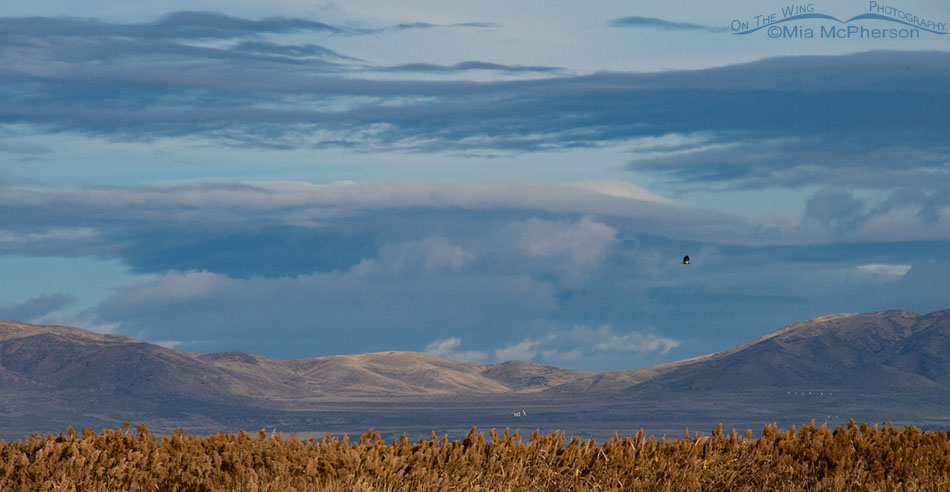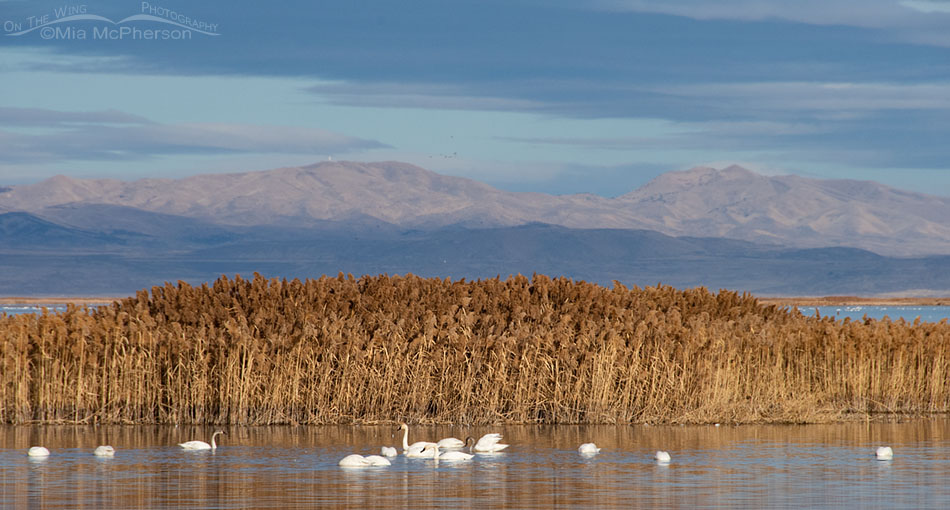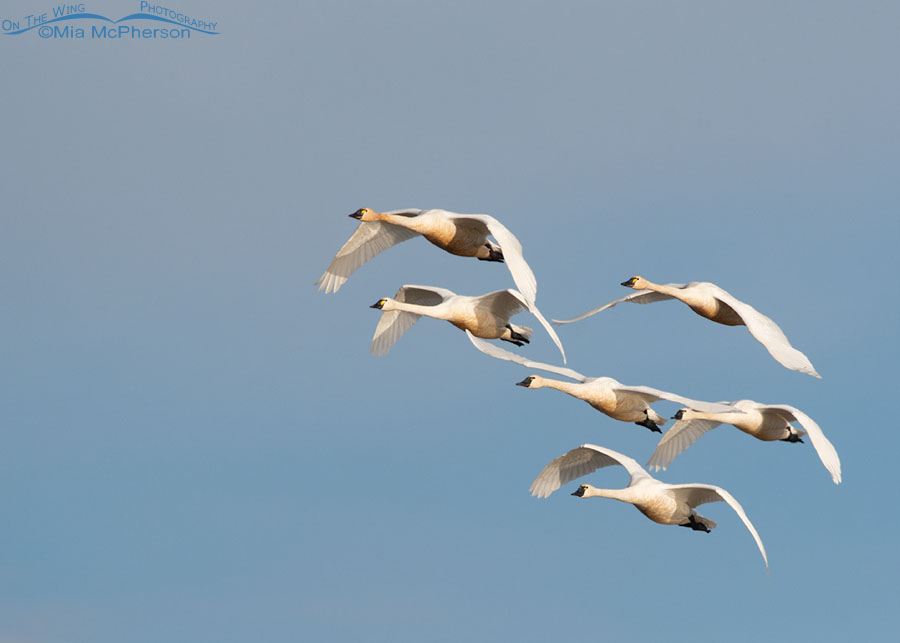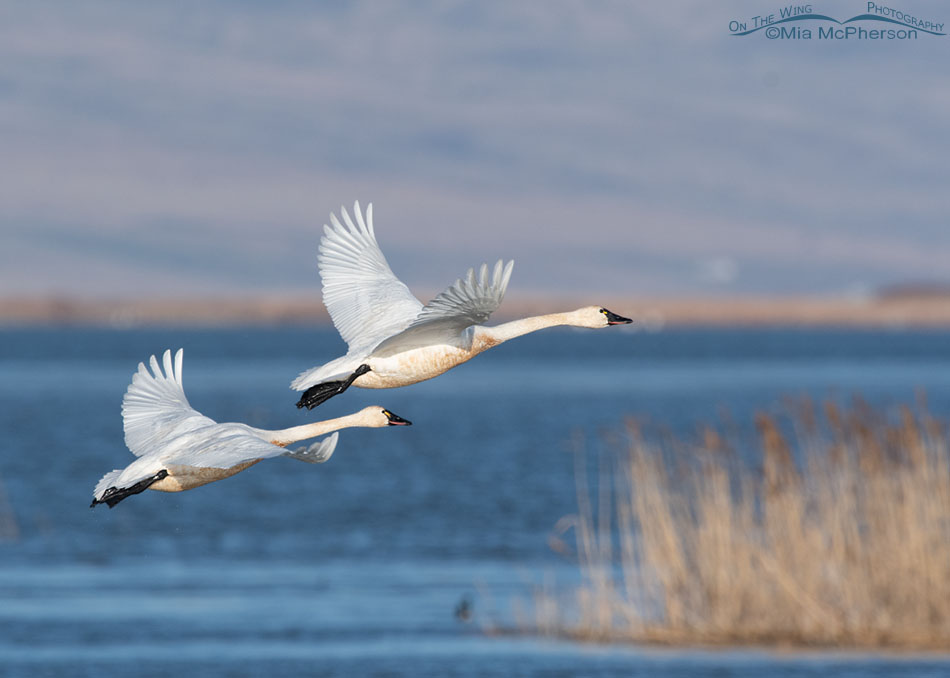 Long distance view of Tundra Swans in flight with an immature Bald Eagle – Nikon D810, f11, 1/1250, ISO 500, Nikkor 18-200mm at 200mm, natural light
Long distance view of Tundra Swans in flight with an immature Bald Eagle – Nikon D810, f11, 1/1250, ISO 500, Nikkor 18-200mm at 200mm, natural light
This morning I noticed in my Facebook memories that I saw and heard my first of season Tundra Swans at Bear River MBR on this date in 2015 and that made me happy. On my next trip to Bear River MBR, Farmington Bay WMA, or on the road any where to the north of where I live I could see Tundra Swans flying in the sky again. I also love listening to large flocks of Tundra Swans calling any time of the day and I have missed hearing them deeply. Their calls touch something deep inside of me and they remind me that I am part of nature.
The photo above shows a long distance view of Tundra Swans in flight although they might be hard to see. There is a small group of Tundra Swans near the center of this photo just above the phragmites and a second group near the right side of the frame a little higher than the first group with two additional swans below those. Flying higher than the swans there is an immature Bald Eagle in front of the clouds above the mountains. There are times that I never see the swans any closer than this photo shows but even then I can feel my pulse quicken.
 Tundra Swans feeding in wetlands at Bear River MBR – Nikon D810, f11, 1/1250, ISO 500, Nikkor 18-200mm at 200mm, natural light
Tundra Swans feeding in wetlands at Bear River MBR – Nikon D810, f11, 1/1250, ISO 500, Nikkor 18-200mm at 200mm, natural light
When I can I like to pick up my backup camera and take photos of the Tundra Swans that show wide views of them in their wetland habitat. These are views I often see when the Tundra Swans are here in northern Utah and I treasure them. What isn’t to like about a view like this?
 Six adult Tundra Swans on the wing – Nikon D500, f7.1, 1/3200, ISO 640, +0.3 EV, Nikkor 500mm VR with 1.4x TC, natural light
Six adult Tundra Swans on the wing – Nikon D500, f7.1, 1/3200, ISO 640, +0.3 EV, Nikkor 500mm VR with 1.4x TC, natural light
Yet I also enjoy using my longer lens to photograph groups of swans on the wing over the wetlands and marshes that I find the swans in while they are in my neck of the woods. These large, white swans look beautiful against clear blue skies or against dark and stormy clouds.
 Two adult Tundra Swans flying over wetlands – Nikon D500, f8, 1/2500, ISO 500, Nikkor 500mm VR with 1.4x TC, natural light
Two adult Tundra Swans flying over wetlands – Nikon D500, f8, 1/2500, ISO 500, Nikkor 500mm VR with 1.4x TC, natural light
Photographing just one or two Tundra Swans up close is equally delightful to me and when I can I will take hundreds of photos of the swans lifting off or landing from the open water of the marshes.
Because of clouds, wind, and rainy weather in the forecast it is going to be a few days before I get out into the field but I am hoping that I will see or hear some Tundra Swans when I head out again.
Life is good.
Mia
These Tundra Swan photos were taken in 2018.
Click here to view more of my Tundra Swans photos plus facts and information about this species.


Love your photos and hope, too, to get to BRMBR to see them one day.
Amen to the others’ comments,,,so very beautiul!!!
Oh, how I miss my Tundra Swans. Thanks for the “fix”. I think my favourite photo (not my “best”) was of a Tundra Swan standing next to a Canada Goose in the same field. Your shots are gorgeous.
I hope you see and hear them again soon.
The composition of the last photo is perfection. The open space on right gives a sense of where the swans are flying. Their relative positions (not eclipsing each other) is like winning the lottery!
Hi Mia,
How long do the Tundra Swans stay in the Salt Lake area? We would like to plan a trip to come to the Bear River MBR, but don’t want to come during hunting season.
Thanks,
Kim Beck
Kimberly, The swans stay until the water freezes and then move on. It is hard to say when that happens but I have had better luck photographing the swans starting in late winter, around the end of the first week of February until the beginning of March, when they come back on their way north. By that time waterfowl hunting has slowed down considerably.